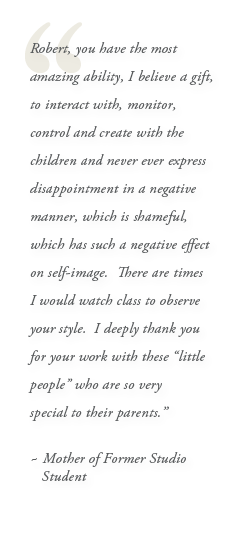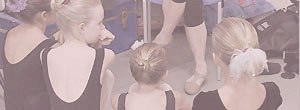

Frequently Asked Questions • FAQs
• How is level placement determined?
Levels are determined by age in the Preparatory Ballet Program. Ages four to six attend Pre-Ballet and seven-year-olds are placed in Primary. Eight-year-olds are placed in Level Ia of the Professional Training Program. Older students without prior experience are placed in Ia or in the Beginning Teen class, depending on their age as well as intellectual and physical development.
Students with experience at other schools will attend a class (designated by our staff) as an evaluation. The instructor will carefully evaluate the student's level of ability, sometimes this process takes more than class to evaluate. Many times we place a student in a lower level so we can fill in some missing pieces in their technique before they advance. The basics are paramount to classical ballet technique, and proper alignment is necessary to avoid injury. We find many schools do not spend enough time on these basics, so don't be alarmed if your child is asked to repeat some skills or start in a lower level that may have been prior, until they are truly mastered. This way we ensure the student will progress much faster and more safely through our program.
• How do I receive feedback on my child's progress?
In the lower levels, our instructors make an effort to check in with parents at regular intervals. Most of the progress your child makes will be slow and steady, as classical ballet is a long process. Parents of students in Levels II and up are encouraged to sign up for an annual Parent Conference with the directors in the spring. Conferences are offered in 15-minute intervals, enough time to answer your questions and give you an update on your child's progress.
• Why do I have to pay a full month's tuition in months like December when there are so few classes?
Our tuition is based on the entire school year, from September through the last class held in June. We offer several payment options for your convenience. Tuition, across each payment option, isdivided into equal installment amounts. Semester plans pay two equal payments; quarterly plans pay four equal payments; monthly plans pay nine equal payments. Over the years, we have found these methods of payment the least confusing for our clients.
• What if my child just wants to dance for fun and not become professional?
All of our students learn skills necessary for a successful career in any field, including organizational skills, superior concentration levels, coordination skills, overall physical fitness, quick learning skills and agility, memory skills, confidence, grace under pressure, the ease of being in front of an audience, exceptional work ethics . . . these are only a few of the benefits of our training, on to a professional career or not.
Many of our students who once thought they did not want to pursue a career in dance change their mind part way through their training. The wonderful feeling of achieving a long-term goal and the pursuit of beauty as art prove so rewarding to our students that they often decide to strive for a dance career. Sometimes they discoer they have an inherent talent for the art form that they did not expect nor were aware of...
Whether they pursue a career or not, they will benefit from our training. They will carry these skills and a love for dance with them for the rest of their lives.
• If my child wishes to have a career in dance, how will The Studio staff help her/him reach their goals?
Our professional faculty has years of experience and our syllabus has been proven year after year to produce outstanding results. Our teachers will guide each student through the myriad of skills as they progress and master technical skills and gain confidence. Eventually, each student learns how to sel- correct, which is a key to becoming a good dancer. We gently help our students understand the discipline of classical ballet training and the demands on both the mind and body. With this knowledge and understanding, most students thrive in our atmosphere of professionalism and accomplishment.
The Studio has helped many students reach their goal of professional dancer. We have an outstanding record of training excellence, our students having received scholarships with many nationally-recognized schools and contracts with professional companies. We believe that if a student really wants to make it happen, they can. We are here to support and develop those dreams. Ultimately it is the hard work and perseverance of the student that will prevail, but there is no substitute for excellent training.
• What "style" of ballet is taught at The Studio?
The Studio syllabus is based on the traditional Vaganova method. Vaganova was developed in St. Petersburg, Russia, by teacher Agrippina Vaganova in the late 1880s. The syllabus she developed became the standard teaching tool still used by many schools today. Our version has been altered to suit our times (i.e. our students don't live at the studio and do have other academic demands) with influences from the RAD (English Royal Academy of Dancing) syllabus as well as the syllabus and methods of the Central Pennsylvania Youth Ballet and American techniques, asdeveloped by George Balanchine. Our syllabus yields a solid classical ballet technique, which is the best base a dancer can achieve.
• Is there a recital/performance where the family can see what our dancer has accomplished?
At the end of each year in June, we present a Student Demonstration. Our demonstration is held in a real theater, so parents can clearly see their child and classmates. However, the demonstration is presented without distracting (and potentially costly) costumes and choreography. The aim of presenting a stripped-down demonstration is so the true technical accomplishments of each level can be viewed and savored. Students are held to a high standard and the demonstration does exactly that: It demonstrates the skills they have mastered during the entire year of study. The progression from level to level on through our most advanced students is truly astonishing. Parents can not only view what their child has accomplished, but can clearly see where they are headed in the future.
We also offer two Parent Observation Weeks during the year. One in the fall and one in the spring. Any and all classes can be observed during these weeks. We encourage every parent to come see their child at work. The atmosphere of concentration at The Studio and what your child is expected to do will amaze you, but it is usually truly awe-inspiring to see what your child actually CAN do.
• Are there any additional fees for costumes or recital as the year progresses?
The Studio does not charge any hidden fees as the year progresses. Any costume pieces used for the Student Demonstration (skirts or hair accessories) will be provided. There is no additional fee for our presentation and each participant receives two complimentary tickets. Additional tickets and DVDs of the Student Demonstration may be purchased.
• My child took years of ballet at another school, why was she/he placed in a lower level at The Studio?
We often find that other schools' basic training lacks clarity. Students were not held to a high standard before being taught progressively difficult steps. Many times we place students in a lower level so we can work with them to correct misalignment or other problems in the basics. It is difficult to correct basics in a higher level, so working with a new student who needs attention in alignment, use of turn out or other basic skills is easier to achieve when the exercises are simpler --then the student can concentrate on the work that needs to be done and excel.
We find that most students who can learn concepts and apply corrections, can correct and strengthen weaknesses and then, having done so, can move through our syllabus at a quicker pace.
• When will my daughter start pointe work (i.e. dancing on her toes)?
We begin preparing female students for pointework at the end of Level II, which is most commonly the third year of study. By this time the student is physically ready for the demands of pointe. Proper alignment of all parts of the body are required, as well as a high level of muscle strength, especially in the legs, abdomen, and back. Also considered is the student's mental capacity. Each student must be able to focus clearly on complicated or difficult tasks and a certain amount of trust in the teacher is also required. Students most often begin pointework at ten or eleven years of age, but a physically developed and mentally prepared student may start as young as nine years, and older students may also begin pointe work when they have developed the skills required.
• What is the dress code, and why is it required?
Yes, we do have a dress code, and it can differ from varying levels. Please visit our webpage at dresscode.html, which details the specific dress requirements for each of our programs.
Classical ballet training demands correct body alignment and placement, from the earliest stages. The only way an instructor can see this alignment is with the student attired in form-fitting clothing, including tights and leotard (or close-fitting t-shirt for boys). The hair is worn up and off the face and neck, not only so the steps can be executed properly (i.e. head can move freely without hair flying in the face), but also so the instructor can see alignment of the head and neck, which is also important.
We require full-soles technique shoes in our Professional Training Program to help the student's foot pointe more strongly. Split-soled shoes are easy to pointe and do not help the foot build the strength necessary for long hours in the studio that a career will require. We allow our students to wear a leotard and tights in the colors of their choosing for the first class of each month. Colored leotards (and tights for boys and men) are allowed during summer programs. Visit our dresscode.html page for more details.
My son/daughter is yearning for ballet lessons. What is the right age to start?
If your son or daughter is interested in ballet lessons, we recommend you get them started when they turn four. Ages four through eight or nine are optimum ages for beginning ballet. That said, anytime can be the right time. Dancers younger than eight can start learning about the art form before they are ready to embark on professional-level training. Professional level training takes a good deal of mental and physical stamina. An hour-long class is a long time for many children to concentrate.

